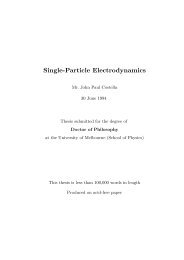HERF Data #3 - Assassination Science
HERF Data #3 - Assassination Science
HERF Data #3 - Assassination Science
You also want an ePaper? Increase the reach of your titles
YUMPU automatically turns print PDFs into web optimized ePapers that Google loves.
Likewise, the DO-160C associated results are dominated by one or two emitters in each category.<br />
If these emitters (e.g., a mobile AN/MPN14 in Denver and an AN/SPY-1 emitter in Seattle) are<br />
not actually in fulltime use or have significantly different operating characteristics than those<br />
used in this study, the corresponding probabilities could drop by one or two orders of magnitude.<br />
The DO-160B associated probabilities, however, are much less likely to suffer from aircraft or<br />
emitter position errors or even from particular emitter characteristics. This is because these<br />
relatively low levels are exceeded for many emitters on each flight, a single aircraft position, or a<br />
single emitter.<br />
REVIEW<br />
A study has been completed to assess the risk of HIRF for transport and nontransport (fixedwing)<br />
aircraft in the U.S. The approach to the assessment incorporated:<br />
• detailed information on emitters and flights near two major cities<br />
- A total of 5913 flights of transport category aircraft involving a takeoff or landing<br />
in either the Denver or Seattle area were examined. A total of 893 emitters<br />
ranging in frequency from 500 kHz to 40 GHz were used, with some reasonable<br />
assumptions, to calculate electromagnetic field strengths at aircraft positions.<br />
• quantitative judgments based on industry experience with aircraft and avionics<br />
- Dave Walen of the FAA and Richard Hess of Honeywell Flight Systems acted as<br />
resources with regard to the types of avionics on aircraft, their properties and the<br />
probabilities of different kinds of responses.<br />
• HIRF environment levels from regulatory and standards sources<br />
- The probability of a catastrophic aircraft event was estimated for three different<br />
HIRF threat levels:<br />
1. DO-160B-derived field strengths<br />
2. DO-160C-derived field strengths<br />
3. NPRM certification field strengths<br />
No reliable evidence was found to suggest that flights in the Denver and Seattle areas experience<br />
electromagnetic fields in excess of the NPRM certification levels. Worst case upper limits are<br />
estimated at ~2e-6 and ~1e-5 for transport and nontransport category aircraft, respectively. DO-<br />
160C associated HIRF catastrophic event probabilities are one to two orders of magnitude larger<br />
and DO-160B probabilities are three to four orders of magnitude larger than these pessimistic<br />
upper limits.<br />
17








